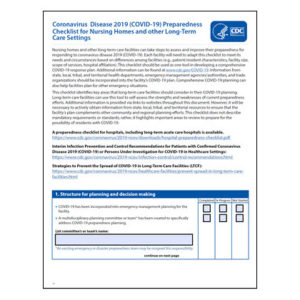Surviving Flu Season
This annual scourge can be a major health threat for residents and staff.
For the general public, flu season can be a difficult time of illness and discomfort. But for residents and staff at long-term care facilities, the flu can be more than a nuisance — it can be downright deadly.
“Seniors are considered to be among the high-risk populations that are high priority for vaccination coverage because older adults are more likely to become seriously ill from the influenza virus,” says Dr. Tanya Gure, section chief of geriatrics and associate professor in internal medicine at the Ohio State University Wexner Medical Center.

Dr. Tanya Gure, section chief of geriatrics and associate professor in internal medicine at the Ohio State University Wexner Medical Center
A younger person may feel quite ill and be sidelined for a few days, but in older adults flu can be fatal because “seniors are more likely to have certain high-risk medical conditions that may cause an older adult to become seriously ill from the flu,” Gure says. The Centers for Disease Control and Prevention (CDC) note that older adults don’t always show the same symptoms of flu as younger adults, which can make it more difficult to identify infection and quarantine patients before they spread the disease to others.
The risk of flu infection is especially high in long-term care facilities, which tend to be populated exclusively with older adults who are in those high-risk categories. This is exacerbated by the open and social nature of many of these facilities, the CDC reports. “In many LTC facilities (LTCFs), an open environment is encouraged, where residents can come and go freely, can intermingle between units, on outings, and in the dining room, and can regularly visit their families on passes. This open design and encouragement of free movement contributes to a greater risk for transmission and dissemination of flu infection.”
Staffing at many facilities can also increase risk, the CDC notes. “High staff turnover — with multiple floating staff who come in and out without always knowing standard facility protocols — poses a challenge to the implementation and enforcement of preventative measures, diagnostic procedures, and management of flu cases.”
Despite these risks, there is an effective way of limiting the chances that flu will gallop through your long-term care facility. Vaccination.
“The most important strategy in preventing severe cases and death from flu is to vaccinate as many residents in assisted living, long-term care and subacute care as possible,” Gure says. “All facilities should have a coordinated approach to vaccinating seniors in the fall before flu activity picks up in late fall-winter,” because “flu viruses are most common during the fall and winter.”
“Flu season timing and duration can vary, but influenza activity often begins to increase in October. Flu activity peaks between December and February, although activity can last as late as May.”
That means you should already be working on vaccinating residents. “The Centers for Disease Control and Prevention recommends getting vaccinated by the end of October,” Gure says. Recommended vaccines include:
- Quadrivalent influenza vaccine. This type can be given to all age groups, including seniors. It contains four strains of influenza virus — two types of Influenza A and two of Influenza B.
- High-dose trivalent. Gure says this type of vaccine is “strongly recommended for older adults 65 years of age and older. If it’s not available, then it’s OK to get the quadrivalent flu vaccine.” However, she says the high-dose trivalent vaccine is preferable “because it has a higher concentration of influenza antigen than the standard quadrivalent influenza vaccine. As a result, it is more effective in reducing flu cases in seniors and reducing health complications from the flu.”
The need for vaccination doesn’t stop with residents. Although staff may be younger and healthier in general, they can still contract and transmit the flu virus to residents and each other.
If you have residents or staff who are reluctant to be vaccinated, additional education may also help them understand that it’s really in everyone’s best interest to stop the disease before it starts. “I discuss the influenza vaccine with all of my patients this time of year,” Gure says. “Since I’m a geriatrician, I consider it of high importance to educate my patients on the fact that they are at higher risk of getting very sick from the flu and developing complications like pneumonia due to the respiratory illness from flu or have an exacerbation of a chronic health issue because they are sick with the flu. It’s rare that there is a legitimate reason for patient refusal, like a documented allergy. So, I review at length the overwhelming benefits of getting the influenza vaccine for the patient and their loved ones.”
If simply presenting the facts doesn’t work, Gure recommends digging a little deeper. “Another approach I take for patients who are reluctant to get influenza vaccine and have no legitimate reason why they shouldn’t get it is to find out about the health status of family and friends with whom they are in close contact. In talking, I often discover that there are loved ones who are also among groups that are high risk for having severe illness from the flu, such as those with chronic illness, children, pregnant women and those who are immune-compromised. Patients are often very receptive to getting the flu vaccine to protect their loved ones even if they are ambivalent about getting it for their own benefit.”
In addition to vaccination, educating staff and residents on how to reduce the risk of flu virus transmission — such as frequent handwashing — should also be part of your strategy for containing the virus.
Even if you vaccinate and educate staff and residents, there’s still the possibility that flu will find its way into your facility. If this happens, you should have an established protocol in place to help contain its spread, Gure says.
“If there is a case of flu within a facility, the facility’s infection control leadership should have a protocol to quarantine the infected individual by keeping the infected individual in their room and wearing a facial mask when they are out in shared spaces. In addition, healthcare workers in nursing homes should wear protective equipment (facial mask, gown and gloves) during patient contact when dealing with body fluids such as blood and respiratory secretions.”
And don’t overlook the potential for visitors to bring the virus into your facility, too. “Family and friends who are visiting loved ones in care continuum communities should plan to be vaccinated and frequently wash hands especially before and after eating. If a visitor comes down with the flu, I advise that they stay away until they have fully recovered to avoid transmitting it to other residents,” Gure says.

Elaine K. Howley is a freelance journalist for various publications. An award-winning writer specializing in health, fitness, sports and history, her work has appeared in numerous print and online publications, including U.S. News, AARP.org, espnW, SWIMMER magazine and Atlas Obscura. She’s also a world-record holding marathon swimmer with a passion for animals and beer. Contact her via her website: elainekhowley.com.
Related Articles
Topics: Featured Articles , Infection control , Resident Care , Staffing











